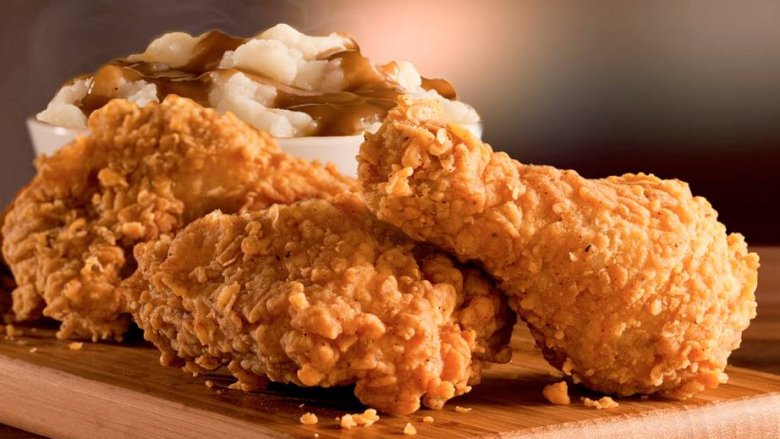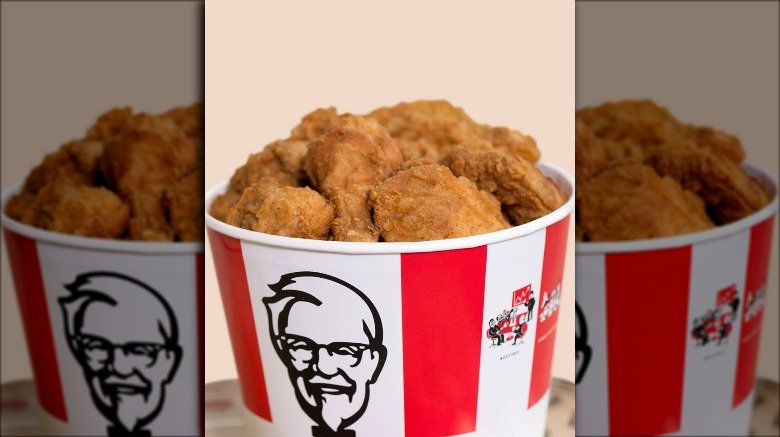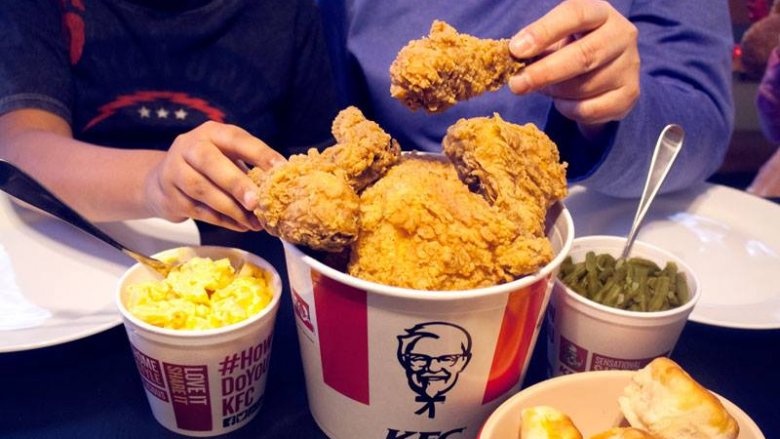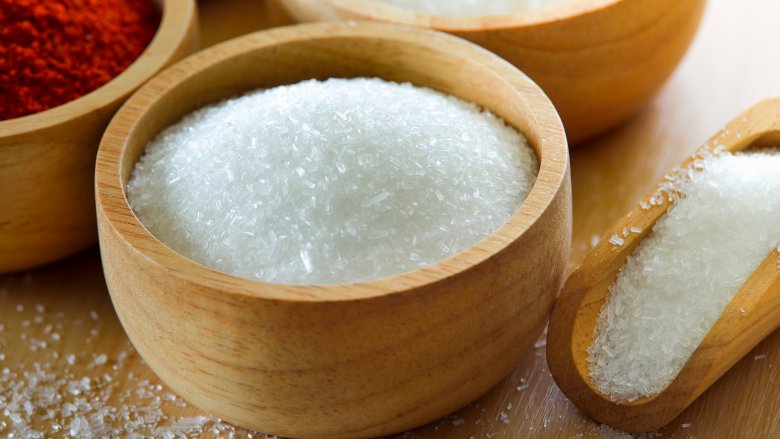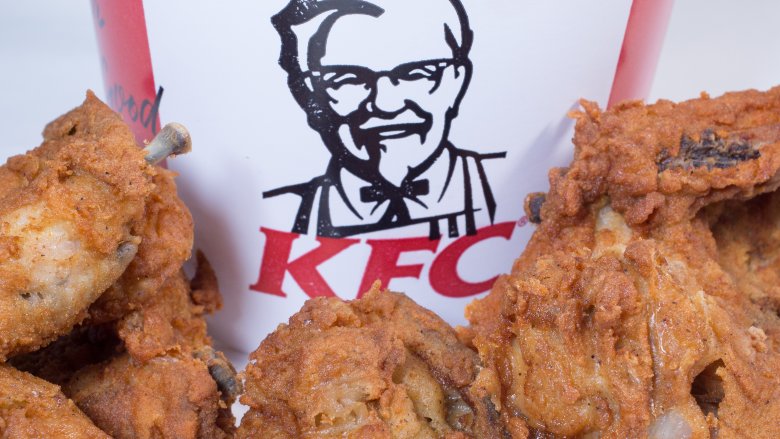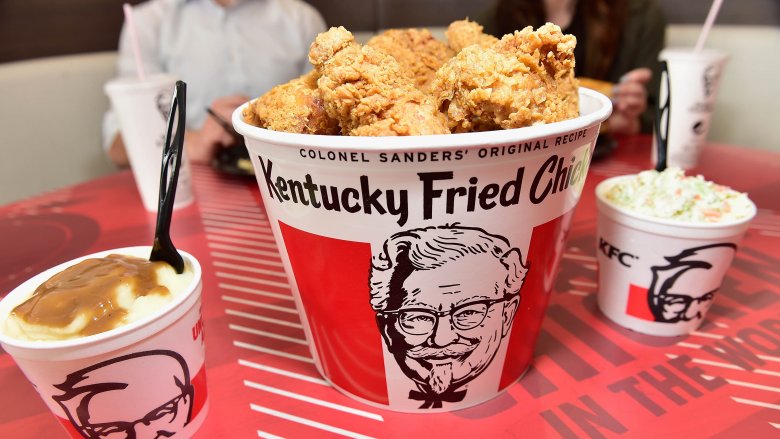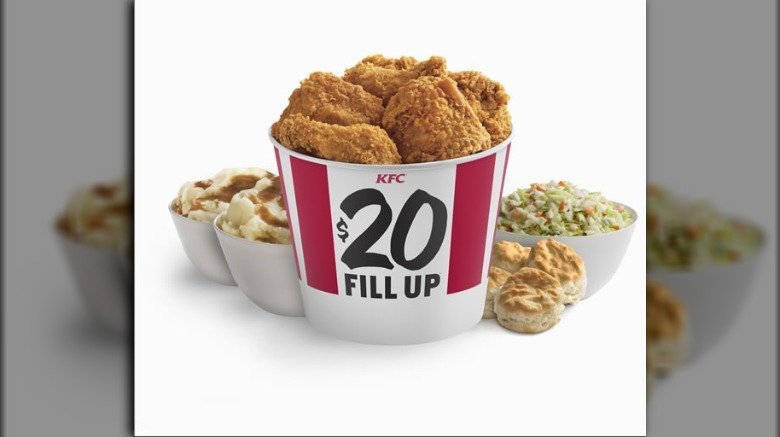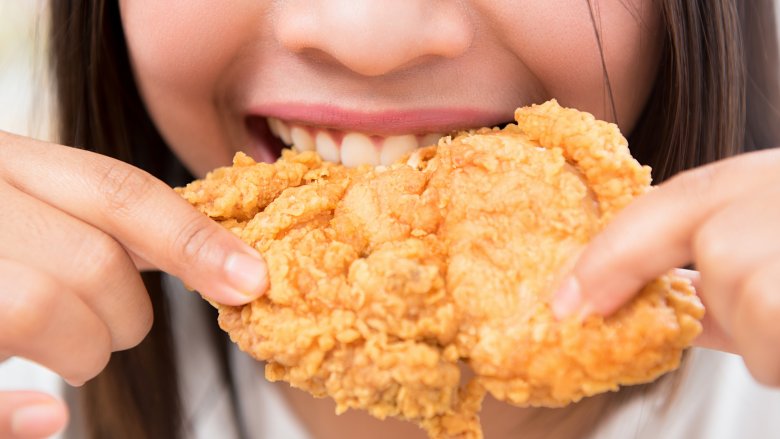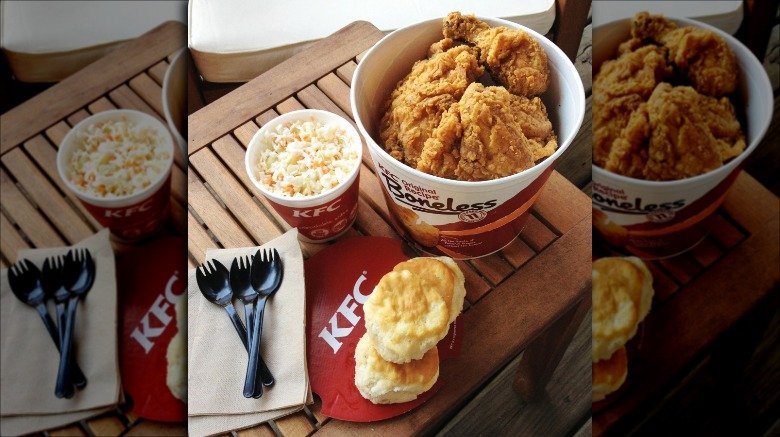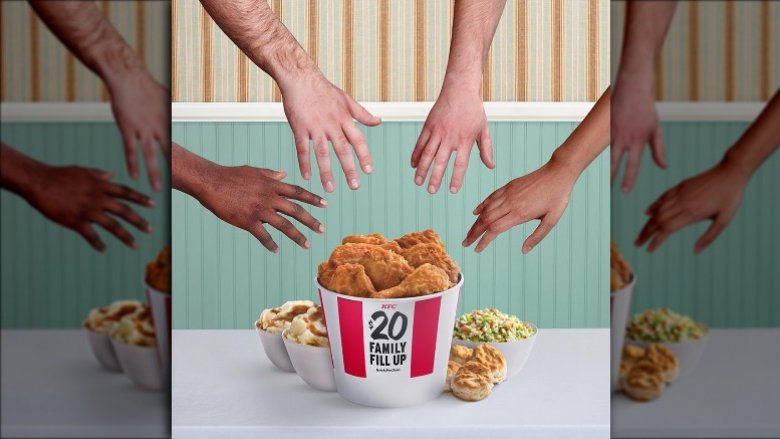This Is Why KFC's Fried Chicken Is So Delicious
It goes without saying there are plenty of fast food joints that serve fried chicken — purveyors of piping hot poultry, if you will. And they're probably all valid in their own unique ways. But, let's be real, when you've got a craving for some killer fried chicken, your car basically pilots itself to one drive-thru in particular: KFC's. And when the word "chicken" is part of a restaurant's name (or it started that way, in any case), you know they take the stuff seriously.
It's a good thing, too, because fried chicken deserves a sort of culinary reverence. The dish's roots in American history are storied and complex, but it remains one of the nation's most beloved comfort foods. It's something you never really get tired of sinking your teeth into, especially when it's done right — and KFC tends to do it better than most.
So, what is it that sets KFC apart? We decided to explore what makes this fried chicken so finger lickin' good.
Those 11 herbs and spices, y'all
Much has been made in KFC's history of its proprietary blend of 11 secret herbs and spices. However, in the culinary world, it's essentially the equivalent of an urban legend — no one has been able to confirm precisely what comprises that proprietary blend. Or have they? In 2016, the real-life nephew of KFC's legendary mascot, Colonel Sanders, purported to give out the top-secret list.
That year, Chicago Tribune reporter Jay Jones traveled to the small town of Corbin, Kentucky, where Colonel Harland Sanders first began serving his now-world-famous fried chicken. There, he met Sanders' nephew Joe Ledington, who shared with Jones a family scrapbook. And there, scribbled on the back of a living will was a handwritten list labeled "11 Spices — Mix with 2 Cups White Fl." What were the supposed 11 spices? Salt, thyme, basil, oregano, celery salt, black pepper, dried mustard, paprika, garlic salt, ground ginger, and white pepper (the last of which Ledington called the "secret ingredient").
Since KFC's official blend of 11 secret herbs and spices has never been verified beyond a shadow of a doubt, it's unclear just how accurate Ledington's list was. However, suffice it to say that whatever they're putting on that chicken makes it pretty darn delicious.
It touches on all the important tastes
Whenever you get a craving for KFC chicken, it's the only thing that will satisfy the raging hunger beast inside of you. You don't necessarily know why it's so fulfilling to chomp down into a piece, but it is. And, in a Quora thread exploring KFC chicken's inherent appeal, Chef Martin Bayer pointed out one possible reason you just can't seem to get the Colonel's menu out of your mind (or your mouth).
"KFC fried chicken tastes good because it is formulated to taste good. Sure, they brag about their 11 herbs and spices, which is great, but that's not what you are tasting when you bite into some extra tasty crispy," Bayer explained. "You are tasting sweet, salty, and umami, or savoriness. The human mouth craves those flavors and that is what makes you go back for more KFC."
While two of the official tastes (bitter and sour) don't present in KFC's fried chicken — which, c'mon, is surely a good thing — Bayer makes a salient point. Per Savory Simple's Jennifer Farley, who studied culinary arts at L'Academie de Cuisine, food that is more balanced among the tastes is more appealing to the palate.
Three letters: M-S-G
Remember the previously aforementioned tale about the Chicago Tribune supposedly sniffing out KFC's secret blend of herbs and spices? Well, once they had their hands on what was allegedly the magic formula, they decided to put it to the test. They took to the kitchen in an attempt to replicate the fast food eatery's signature fried chicken flavor. After several batches, they realized something was missing — at which point they made a surprising discovery.
After multiple batches that weren't quite right, the Tribune team came "very close" to recreating the taste of the Colonel's secret blend. Then, on a whim, a reporter grabbed a container of the MSG flavor-enhancer Accent sitting in the test kitchen and sprinkled it on top of the chicken. Voila! According to the paper, their test chicken was "virtually indistinguishable" from the bucket they bought at KFC. When the Tribune reached out, a KFC spokesperson reportedly confirmed that they do use MSG in their Original Recipe chicken.
Don't let that deter you, though. While MSG tends to get a bad rap, U.S. News & World Report says the negative publicity is undeserved. Per the outlet, MSG — or monosodium glutamate — is simply a combination of sodium and glutamate, an amino acid found naturally in many foods like mushrooms and tomatoes. And guess what? "The body digests the MSG seasoning and glutamates in foods the same way and cannot tell the difference between the two," states the outlet. Plus, it makes food taste really good.
The number 7
In 2014, KFC offered near-total transparency by inviting Gizmodo to go behind the scenes for a tour of the restaurant's headquarters in Louisville, Kentucky. There, Gizmodo's reporter even tied on an apron in the KFC company kitchen and cooked up a little fried chicken of their own. But during the enlightening play-by-play of how the signature chicken is made, the reporter found that KFC is obsessed with the number seven. And, surprisingly, it actually plays a big part in making KFC's chicken taste so good.
In preparation for its breading, the chicken is inspected and then dunked in a brine. To dry the chicken off, KFC employees toss it — you guessed it! — seven times. The chicken is then placed in the breading using a pseudo breaststroke motion seven times. When it's good and coated, the chicken is collected in a basket and see-sawed seven times. Finally, the chicken is placed on the frying rack and pressure cooked to perfection.
So, you see, without KFC's commitment to doing things seven times, the chicken likely wouldn't be quite so flavorful.
They pressure cook it
When you think of someone making fried chicken, you probably think of them submerging it in a bubbling vat or iron skillet filled with oil. While KFC has always used oil, it originally used it in a decidedly different way: by basically hacking a pressure cooker. For the record, the Colonel lived on the edge — using oil in a pressure cooker not meant for oil was dangerous. Fortunately, by the late 1950s a commercial pressure fryer specifically suited to this person was developed. And although many other restaurants have undoubtedly gone on to adopt the oil-and-pressure cooking method, according to Josh Ozerksy's Colonel Sanders and the American Dream (via Slate), KFC really pioneered pressure cooking with hot oil in the 1940s.
The science behind why pressure cooking makes fried chicken taste so amazing is, well, kind of amazing. As explained by Chef Jacob Burton with Stella Culinary, "The collagen in tough pieces of meat like the leg and thigh break down much faster... yielding a tender product with less cook time. Less moisture from the product is evaporated, leading to a juicier piece of meat." Or, in KFC's words, their chicken is "pressure cooked at a low temperature to preserve all the great taste we're known for around the world."
Fresh chicken, not frozen
It would be easy to assume KFC and other fast food restaurants like it use frozen meat products for all of their menu offerings. Doing so would presumably amount to a significant cost savings over fresh proteins. But according to several former employers on a Quora thread devoted to how KFC chicken is cooked, the restaurant is committed to using quality fresh ingredients.
Said former employee Daniel Schroeder, "Our chicken was always fresh; chilled, but not frozen. It was supplied by a local poultry company, and already cut into pieces: leg, thigh, breast, & wing. There was nothing really special about the chicken itself; the poultry supplied numerous other restaurants with chicken, so it was all actually chicken... KFC, at least from my experience, is very picky about their food."
Robert Lawrence, who worked at KFC for almost six years, elaborated on the chicken procurement process. "The chicken was delivered to the restaurant in these big, plastic totes with snap-on lids," he said. "The chicken itself arrived pre-cut and packaged into what we called a '9-cut,' which was a mesh bag containing 2 legs, 2 thighs, 2 ribs, 2 wings, and 1 breast... essentially, one chicken (one chicken = 'one head')."
Fresh is best, right?
We're hard-wired to desire high calorie density
Whenever you tear into a juicy bite of chicken, just tell yourself that you're simply following your evolutionary cues. Yep, that's right — you can thank your ancestors for your primal need to dive headfirst into a bucket of Extra Crispy. Business Insider has a breakdown of why the blame belongs with someone in your family tree who came way, way, way before you.
"Because humans evolved as foragers, our brains learned to recognize and desire things that pack a lot of calories," Business Insider explained in 2016. "The caloric density scale ranges from 0 for water to 9 for pure fat." Wondering where KFC stacks up? Let's just say this chicken should satisfy the forager within. "While raw chicken without the skin has a caloric density of 1.35, KFC's original chicken breast scores 2.3. The extra crispy version gets a 2.9. The skin by itself scores an intoxicating 5.0."
To put it plainly, our ancestors knew that in order to survive on a sparse diet while still having to plunder for food and travel great distances, they needed calorie-rich food to sustain them. So, if anyone ever questions your devotion to KFC's fried chicken, just tell them it runs in the family.
A potent punch of salt
It's a well-known fact of life that salt makes everything taste better. It doesn't matter how bland it is, salt can bring it back to life. Even if the flavor profile is near perfect, salt can make it better. So, is it really surprising that KFC's scrumptious chicken is chock-full of sodium? Nah. That clever Colonel Sanders knew exactly what he was doing.
In an interview with NPR in 2012, researcher Paul Breslin at Philadelphia's Monell Center pointed toward the peculiar paradox of humans' love of salt. "If you don't keep up your sodium level in your body, you'll die," said Breslin. But, he continued, "there's no question that people who have high salt intakes are at risk for a heart attack and stroke and death, and that lowering their salt intake will save lives."
Still, people don't let a little thing like looming mortality get in the way of our appreciation for salt. In one international study of salt consumption globally, researchers found that salt might be the unspoken universal language. "All across the planet, with few exceptions, most people consume more or less the same amount of sodium," Breslin told NPR.
This ties into KFC because their fried chicken, as you might have guessed, is incredibly salty — per their own nutrition chart, one Original Recipe chicken breast has a whopping 1,190 mg of sodium.
It's cheap and easy
Sometimes the food that's the best is the food that's quick and affordable, and KFC's chicken is nothing if not both. As outlined by Fast Food Menu Prices, most of KFCs menu items are a steal. A two-piece chicken combo will only set you back $5.99. Shoot, you can get an entire 8-piece fried chicken meal with two large sides and four biscuits all for less than $22.
Who doesn't like saving money? Also, it goes without saying that sometimes when you're tired and have been dealing with work or kids or whatever all day, you crave comfort food. According to Psychology Today, this is normal human behavior. "Eating food high in fat, sugar or salt activates the brain's reward system," the publication explains. "Highly palatable foods activate the same brain regions of reward and pleasure that are active in drug addiction."
So what they're saying is, yep! You're definitely addicted to KFC, just as you've suspected for many, many years. Chalk it up to your brain's reward system.
It literally sounds delicious
Here's something you probably don't give much thought to — how your food "sounds" probably affects the way you think it tastes. In a 2015 study, cognitive neurology researchers call sound the "forgotten flavor sense" for its importance to our enjoyment of food. The gist? Our perception of flavor is multi-sensory, as is the actual experience of eating. And this is where KFC has an advantage.
"Indeed, it turns out that crispness and pleasantness are highly correlated when it comes to our rating of foods," the study reads. This obviously bodes well for KFC's Crispy and Extra Crispy chicken recipes. "In fact, once you realize just how important the sound is to the overall multi-sensory experience, you start to understand why it is that the food marketers spend so much of their time trying to accentuate the crispy, crunchy, and crackly sounds in their advertisements," says the study.
It's possible that our brains associate crispness with freshness, thereby signaling to our inner ancestral foragers that the crispy chicken contains the kind of vitamins and nutrients that our bodies need.
It tastes just as good cold
Make no mistake: Fresh-out-of-the-pressure-cooker KFC fried chicken really is finger lickin' good. A brand-new hot batch is surely one of the reasons this fast food restaurant has maintained its popularity over the years. But the reality is, most of us can't scarf down all of our order in one fell swoop. So, we do the normal, responsible thing — we stash our leftovers in the fridge.
And you know what? That chicken is just as good cold as it is piping hot. What gives? For starters, eating cold chicken isn't a new concept. Before refrigeration existed, people in the South stumbled upon the fact that cold chicken was rather delightful. Per Southern Kitchen, Southerners back then began to incorporate it into meals as the centerpiece. And although refrigeration would go on to become mainstream, many people still chose to stick with cooled down chicken.
There's a reasonable explanation for this, it would seem. "When fried chicken starts to cool down, the skin contracts and bonds itself to the meat. This process causes the top part of the skin to separate slightly from the crust, which prevents moisture absorption and sogginess, allowing the breading to maintain its satisfying chomp," says Southern Kitchen. "Also, as the steam escapes the chicken, the moisture loss results in meat with greater density and a more pronounced 'chicken-y' flavor."
People just really like chicken
If you find yourself gravitating more and more toward KFC's fried chicken in recent years, you aren't alone. Many other people are also proving powerless to the appeal of this fast food menu item. In 2018, The Guardian explored the resurgence of KFC's popularity, noting that chicken has gained a "hip, urban following." Paul Hemings, a London restaurateur trying to capitalize on the fried bird craze, told the Guardian, "In the last few years, chicken — unless you are a vegan or a veggie — has become the go-to food for millennials. Chicken is having a moment, not just in the U.S. and the UK but around the world. Chicken is where it's at."
This fact isn't lost on KFC, who has been leveraging that surge to their advantage. In recent years, the franchise has been opening new stores at the rate of one every seven hours. As of 2018, they boasted more than 22,000 locations globally, including newer restaurants in Macedonia, Uzbekistan, Albania, and Guyana.
Interestingly, the deliciousness and success of KFC's fried chicken doesn't just make their food taste better to patrons. It apparently helps make all chicken more appealing. "When you put a whole lot of dollars behind something, it reminds consumers they should try a product. Chicken is an extremely popular item with all age groups, and new tastes reinforce that," Bonnie Riggs, foodservice industry analyst for The NPD Group, told QSR in 2017.
